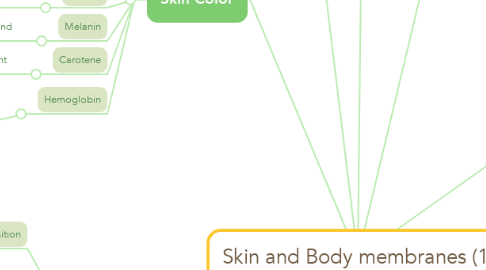
1. Basal cell carcinoma
2. Skin Structure
2.1. Epidermis
2.1.1. Outer layer
2.2. Dermis
2.2.1. Dense connective tissue
2.3. Hypodermis
2.3.1. Composed mostly of adipose tissue
3. Skin Color
3.1. Redness
3.1.1. Blusing
3.2. Pallor
3.2.1. Anemia
3.3. Jaundice
3.3.1. Liver disorder
3.4. Bruises
3.4.1. Hematomas
3.5. Melanin
3.5.1. Amount and kind
3.6. Carotene
3.6.1. Orange-yellow pigment
3.7. Hemoglobin
3.7.1. Red coloring from blood cells in dermis capillaries
4. Sweat
4.1. Composition
4.1.1. Mostly water w/some salts and vitamin C
4.1.2. Metabolic waste and lactic acid
4.1.3. Fatty acids and proteins
4.2. Function
4.2.1. Helps dissipate excess heat
4.2.2. Excretes waste products
4.2.3. Acidic nature inhibits bacteria growth
5. Burns
5.1. First-degree
5.1.1. Only epidermis is damaged
5.2. Second-degree
5.2.1. Epidermis and upper dermis are damaged
5.3. Third-degree
5.3.1. Destroys entire skin layer
5.4. Fourth-degree
5.4.1. Go through both layers of the skin and tissue possibly involving muscle and bone
5.5. Critical
5.5.1. Over 25% of the body has second degree burns
5.5.2. Over 10% of the body has third degree burns
6. Skin cancer types
6.1. Squamous cell carcinoma
6.2. Malignant melanoma
7. Classification of body membranes
7.1. Epithelial membranes
7.1.1. Mucous
7.1.1.1. Known as skin
7.1.2. Cutaneous
7.1.2.1. Surface epithelium
7.1.3. Serous
7.1.3.1. Underlying areolar connective tissue
7.2. Connective tissue membrane
7.2.1. Synovial
7.2.1.1. Areolar connective tissue only
8. Appendages of the skin
8.1. Cutaneous glands
8.1.1. Exocrine glands
8.2. Sebaceous glands
8.2.1. Lubricant for skin
8.3. Sweat glands
8.3.1. Sudoriferous glands
9. Skin Homeostatic Imbalances
9.1. Infections
9.1.1. Athletes foot
9.1.2. Boils and carbuncles
9.1.3. Cold sores
9.2. Allergies
9.2.1. Contact dermatitis
9.2.2. Impetigo
9.2.3. Psoriasis
9.3. Burns
9.3.1. Tissue damage and cell death cause by heat, electricity etc.
10. Appendages of the skin
10.1. Hair
10.1.1. Serves a few minor protective functions
10.1.2. Consists of hard keratinized epithelial cells
10.1.3. Melanocytes provide pigment for hair color
10.2. Nail
10.2.1. Scale like modifications of the epidermis
10.2.2. Stratum basale extends beneath the nail bed
10.2.3. Lack of pigment makes colorless
